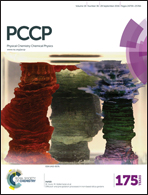A computational study of the competing reaction mechanisms of the photo-catalytic reduction of CO2 on anatase(101)†
Abstract
We perform a computational study of three different reaction mechanisms for the photo-catalytic reduction of CO2 on the TiO2 anatase(101) surface known as (i) the carbene, (ii) the formaldehyde and (iii) the glyoxal pathways. We define a set of approximations that allows testing a number of mechanistic hypotheses and design experiments to validate them. We find that the energetically most favourable reaction mechanism among those proposed in the literature is the formaldehyde path, and the rate-limiting step is likely to be the formation of CH3 radicals from dissociation of CH3OH. We show that an intermediate that supports this mechanism is OCH2OH. We also find that formaldehyde would be an energetically favorable intermediate forming from CO and HCO, intermediates that are proposed in the early stage of the carbene and glyoxal pathways respectively. Some possible variants of mechanisms and methods to ease the formation of CH3 radicals are also discussed.


 Please wait while we load your content...
Please wait while we load your content...